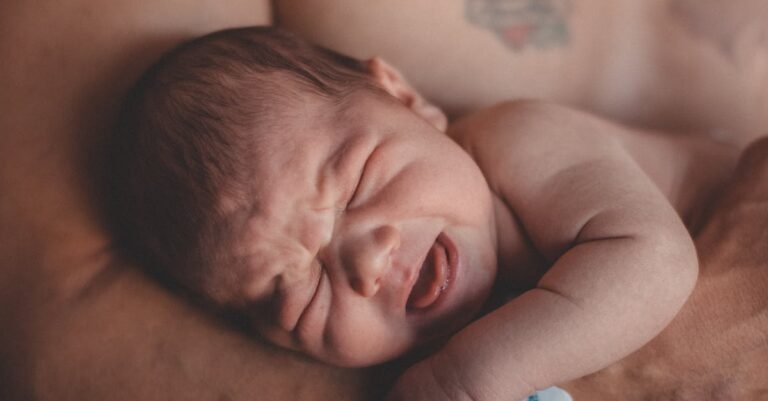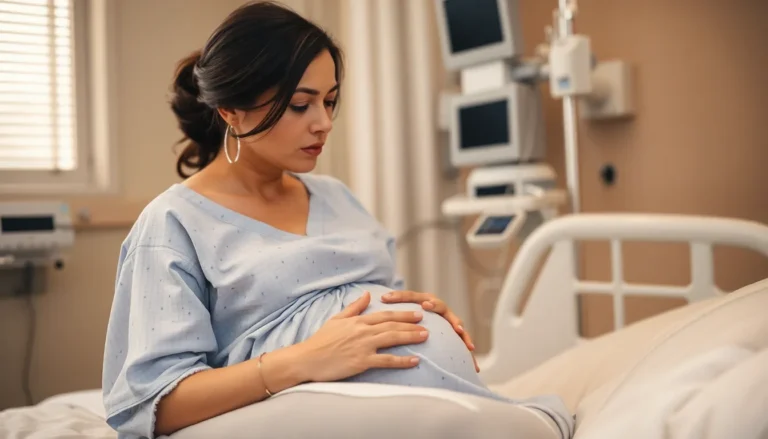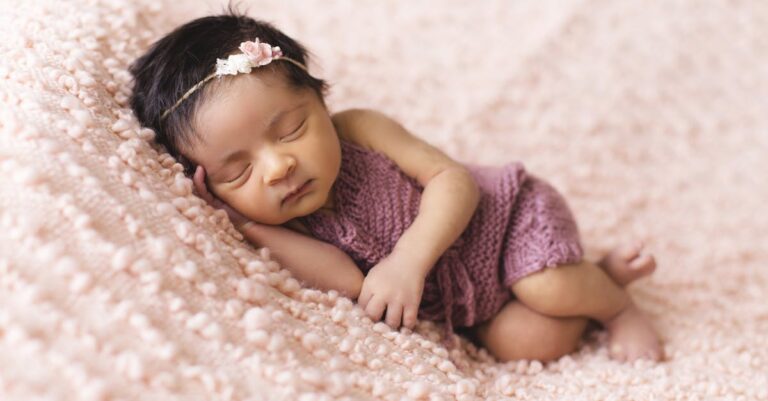When it comes to newborn sleep, parents often find themselves in a world of confusion and worry. With a tiny human in the house, every decision feels monumental—even how they sleep. It’s like trying to solve a Rubik’s Cube while blindfolded. But fear not! Understanding safe sleep positions can turn those sleepless nights into peaceful slumbers for both baby and parents.
Imagine a world where your little one snoozes soundly, and you can finally enjoy that cup of coffee without fear of it going cold. By knowing the safest sleep positions for newborns, parents can rest easy, knowing they’re setting the stage for sweet dreams. Let’s dive into the best practices that keep those tiny bundles of joy safe and sound while they drift off into dreamland.
Table of Contents
ToggleUnderstanding Newborn Sleep Positions
Safe sleep positions play a crucial role in a newborn’s well-being and development. By recognizing the best practices, parents can enhance their baby’s sleep safety.
Importance of Safe Sleep Positions
Establishing safe sleep positions significantly reduces the risk of sleep-related incidents. Research indicates that placing infants on their backs decreases the likelihood of Sudden Infant Death Syndrome (SIDS). Reliable guidelines recommend keeping babies on their backs for all sleep times, including naps. In addition to preventing SIDS, this position promotes better breathing and overall comfort. Creating a consistent sleep environment supports healthy sleep patterns as well.
Risks of Unsafe Sleep Positions
Unsafe sleep positions can pose serious threats to a newborn’s health. Infants placed on their stomachs or sides are at a heightened risk for suffocation. Loose bedding, toys, or pillows within the crib further increase dangerous situations. Studies show that sleeping on these surfaces contributes to SIDS and other sleep-related complications. By being aware of these risks, parents can make informed decisions to ensure their baby’s safety during sleep.
Recommended Sleep Positions for Newborns
Understanding safe sleep positions for newborns is vital for parents. Optimal sleep arrangements enhance both safety and comfort.
Back Sleeping: The Safest Choice
Placing infants on their backs during sleep remains the safest practice. Data shows that this position significantly reduces the risk of Sudden Infant Death Syndrome (SIDS). It supports better breathing, leading to a more restful sleep. Parents should ensure no soft bedding is present in the crib. Additionally, a firm mattress provides the necessary support while avoiding potential hazards, such as suffocation.
Side Sleeping: Considerations and Risks
Side sleeping carries notable risks for newborns. Experts advise against this position due to the increased chance of rolling onto their stomachs. Such movement could potentially elevate the risk of SIDS. While some believe side sleeping aids digestion, it does not compensate for safety concerns. Parents must balance comfort with safety by following current guidelines.
Stomach Sleeping: Why It’s Not Recommended
Stomach sleeping poses significant dangers for newborns. Research consistently highlights that this position increases the likelihood of suffocation. Infants may struggle to breathe properly when placed face down. Moreover, stomach sleeping contributes to an elevated risk of SIDS, making it a hazardous option. Parents should prioritize back sleeping to ensure their baby’s safety and well-being.
Sleep Environment and Safety
Creating a safe sleep environment for a newborn is essential for reducing risks associated with sleep-related incidents. Focus on maintaining a secure crib setup, free from hazards.
Crib Safety Guidelines
Ensure the crib meets safety standards set by the Consumer Product Safety Commission (CPSC). Use a firm mattress that fits snugly within the crib frame to prevent gaps. Place the crib away from windows, blinds, and cords to eliminate potential hazards. Avoid using soft bedding, pillows, and toys, as these can increase the risk of suffocation. Regularly inspect the crib for any wear or damage. Maintaining a clutter-free sleep space contributes to a safer sleeping environment.
Use of Sleep Accessories
Consider the use of sleep accessories with caution. Sleep sacks or wearable blankets provide warmth without the risks associated with traditional blankets. Avoid using crib bumpers, as they pose a suffocation risk for infants. Keep in mind that pacifiers can help reduce the risk of SIDS when used during sleep. Positioning swaddles securely allows for comfort while minimizing the risk of rolling. Selecting age-appropriate sleep accessories enhances the overall safety of a newborn’s sleep setup.
Signs of Sleep Disturbances in Newborns
Newborns may show signs of sleep disturbances that require parental attention. Recognizing these signs is vital for ensuring a healthy sleep environment.
When to Consult a Pediatrician
Consult a pediatrician if a newborn displays excessive sleepiness or difficulty waking. Persistent fussiness during sleep times may indicate an issue. Parents should note any breathing irregularities, such as pauses or gasps. Unexplained crying or discomfort while sleeping warrants a professional evaluation. When sleep patterns deviate significantly from the norm, a healthcare provider’s input can provide clarity.
Common Sleep Issues in Newborns
Common sleep issues in newborns include frequent awakenings and trouble settling down. Many infants experience a tendency to startle easily, disrupting their sleep cycle. Difficulty transitioning between sleep stages can also occur. Some newborns face challenges with self-soothing, leading to fragmented sleep. Understanding these issues can help parents create strategies that promote restful sleep for their child.
Conclusion
Ensuring a safe sleep environment for newborns is paramount for their health and well-being. By adhering to recommended sleep positions and guidelines, parents can significantly reduce the risk of SIDS and create a nurturing space for their little ones. Understanding the importance of placing infants on their backs and avoiding unsafe sleep practices is crucial for fostering healthy sleep habits.
Parents should also remain vigilant in recognizing signs of sleep disturbances and seek professional advice when necessary. With the right knowledge and precautions, they can help their newborns enjoy peaceful, secure sleep while also allowing themselves to rest easy.



